2014 SUBARU TRIBECA window
[x] Cancel search: windowPage 42 of 426
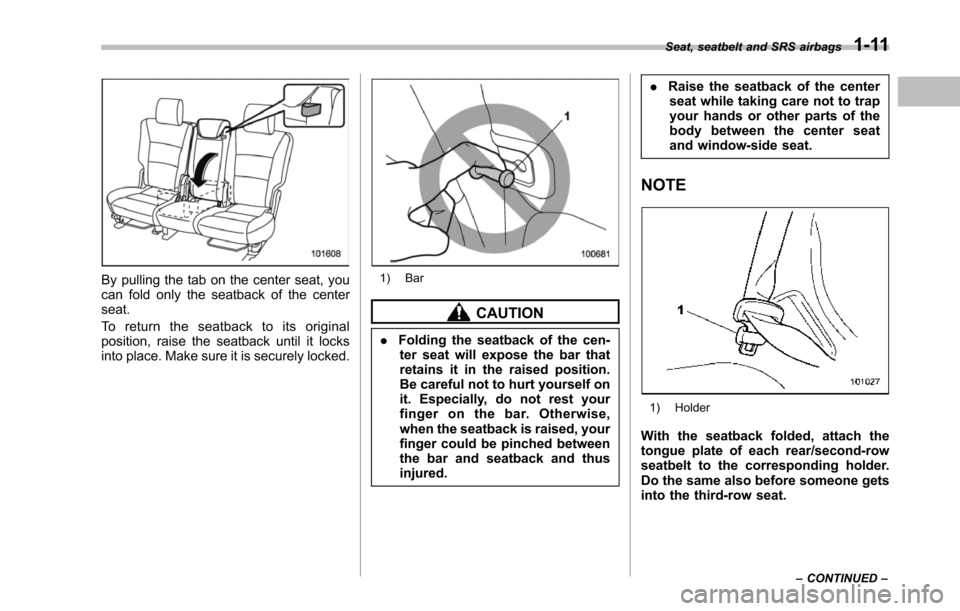
By pulling the tab on the center seat, youcan fold only the seatback of the centerseat.
To r e t u r n t h e s e a t b a c k t o i t s o r i g i n a lposition, raise the seatback until it locksinto place. Make sure it is securely locked.
1) Bar
CAUTION
.Folding the seatback of the cen-ter seat will expose the bar thatretains it in the raised position.Be careful not to hurt yourself onit. Especially, do not rest yourfinger on the bar. Otherwise,when the seatback is raised, yourfinger could be pinched betweenthe bar and seatback and thusinjured.
.Raise the seatback of the centerseat while taking care not to trapyour hands or other parts of thebody between the center seatand window-side seat.
NOTE
1) Holder
With the seatback folded, attach thetongue plate of each rear/second-rowseatbelt to the corresponding holder.Do the same also before someone getsinto thethird-row seat.
Seat, seatbelt and SRS airbags1-11
–CONTINUED–
Page 43 of 426
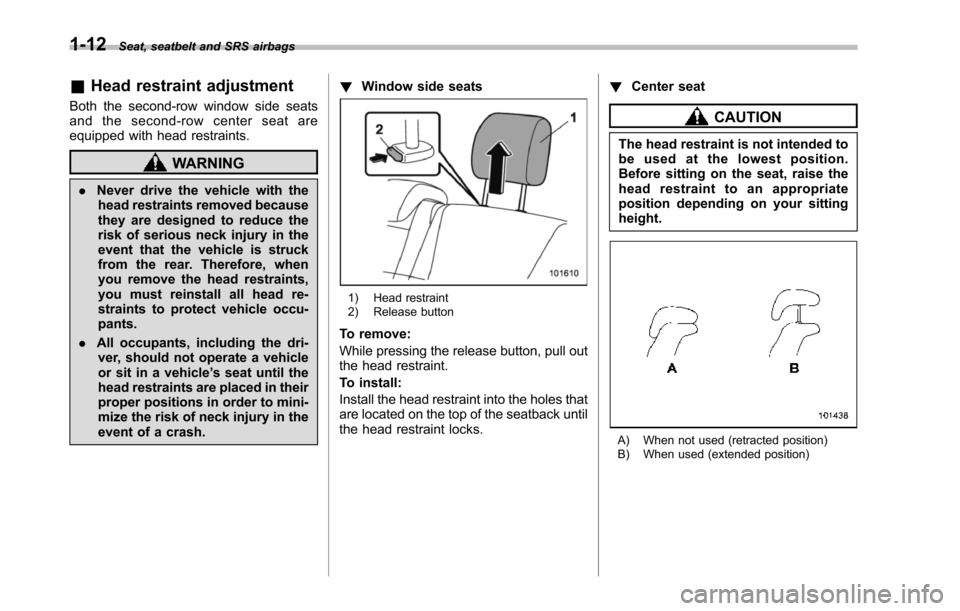
1-12Seat, seatbelt and SRS airbags
&Head restraint adjustment
Both the second-row window side seatsand the second-row center seat areequipped with head restraints.
WARNING
.Never drive the vehicle with thehead restraints removed becausethey are designed to reduce therisk of serious neck injury in theevent that the vehicle is struckfrom the rear. Therefore, whenyou remove the head restraints,you must reinstall all head re-straints to protect vehicle occu-pants.
.All occupants, including the dri-ver, should not operate a vehicleor sit in a vehicle’s seat until thehead restraintsare placed in theirproper positions in order to mini-mize the risk of neck injury in theevent of a crash.
!Window side seats
1) Head restraint2) Release button
To remove:
While pressing the release button, pull outthe head restraint.
To install:
Install the head restraint into the holes thatare located on the top of the seatback untilthe head restraint locks.
!Center seat
CAUTION
The head restraint is not intended tobe used at the lowest position.Before sitting on the seat, raise thehead restraint to an appropriateposition depending on your sittingheight.
A) When not used (retracted position)B) When used (extended position)
Page 49 of 426

1-18Seat, seatbelt and SRS airbags
the face or neck, adjust the shoulder beltanchor height (window-side seating posi-tions only) and then if necessary move thechild closer to the belt buckle to helpprovide a good shoulder belt fit. Care mustbe taken to securely place the lap belt aslow as possible on the hips and not on thechild’s waist. If the shoulder portion of thebelt cannot be properly positioned, a childrestraint system should be used. Neverplacethe shoulder belt under the child’sarm or behind the child’s back.
!Expectant mothers
Expectant mothers also need to use theseatbelts. They should consult their doctorfor specific recommendations. The lap beltshouldbe worn securely and as low aspossible over the hips, not over the waist.
&Emergency Locking Retrac-
tor (ELR)
The driver’s seatbelt has an EmergencyLocking Retractor (ELR).
The emergency locking retractor allowsnormal body movement but the retractorlocks automatically during a sudden stop,impact or if you pull the belt very quicklyout of the retractor.
&Automatic/Emergency Lock-
ing Retractor (A/ELR)
Each passenger’s seatbelt has an Auto-matic/Emergency Locking Retractor (A/ELR). The Automatic/Emergency LockingRetractor normally functions as an Emer-gency Locking Retractor (ELR). The A/ELR has an additional locking mode,“Automatic Locking Retractor (ALR)mode”, intended to secure a child restraintsystem.
The ALR mode functions as follows.
When the seatbelt is once drawn outcompletely and is then retracted evenslightly, the retractor locks the seatbelt inthat position and the seatbelt cannot beextended. As the belt is rewinding, clickswill be heard which indicate the retractorfunctions as an ALR. When the seatbelt isretracted fully, the ALR mode is canceledand the ELR mode is restored.
When securing a child restraint system onthe rear passenger’s seats by using aseatbelt, the seatbelt must be changedover to the Automatic Locking Retractor(ALR) mode. For instructions on how toinstall the child restraint system using aseatbelt, refer to“Installing child restraintsystems with A/ELR seatbelt”F1-32.
When the child restraint system is re-moved, make sure that the retractor isrestored to the Emergency Locking Re-tractor (ELR) mode by allowing the seat-belt to retract fully.
&Seatbelt warning light
and chime
Refer to“Seatbelt warning light andchime”F3-10.
&Fastening the seatbelt
WARNING
.Never use a belt that is twisted orreversed. In an accident, this canincrease therisk or severity ofinjury.
.Keep the lap belt as low aspossible on your hips. In a colli-sion, this spreads the force of thelap belt over stronger hip bones
Page 69 of 426

1-38Seat, seatbelt and SRS airbags
The second-row seat has four loweranchorages (bars) and three upper an-chorages (tether anchorages) for accom-modating such child restraint systems.
The lower anchorages (bars) are used forinstallinga child restraint system only onthe window-side seating positions. Foreach window-side seating position, twolower anchorages are provided.
Each lower anchorage is located wherethe seatcushion meets the seatback.
The tether anchorages (upper an-chorages)are provided for all the seatingpositions of the second-row seat.
On each outboard second-row seat, youwill find marks“”at the bottom of theseatback.
Page 72 of 426

!To hook the top tether
!Second-row outboard seat
1. Remove the head restraint at thewindow-sideseating position where thechild restraint system has been installedwith the lower anchorages or seatbelt; liftup the head restraint while pressing therelease button. Store the head restraint inthe cargo area. Avoid placing the headrestraint in the passenger compartment toprevent it from being thrown around in thepassenger compartment in a sudden stopor a sharp turn.
2. Confirm that there are no obstaclesaround the anchorages.
3. Fasten the top tether hook of the childrestraint system to the appropriate upperanchorage.
4. Tighten the top tether securely.
CAUTION
When the child restraint system is tobe secured using the top tether,pass the top tether under the headrestraint between the head restraintstay posts.
CAUTION
Be sure to install the top tether withthe head restraint raised to thehighest position. If the head re-straint is in any of the lower posi-tions, the top tether will touch thehead restraint and the resultingslack will prevent its secure installa-tion.
Seat, seatbelt and SRS airbags1-41
–CONTINUED–
Page 91 of 426
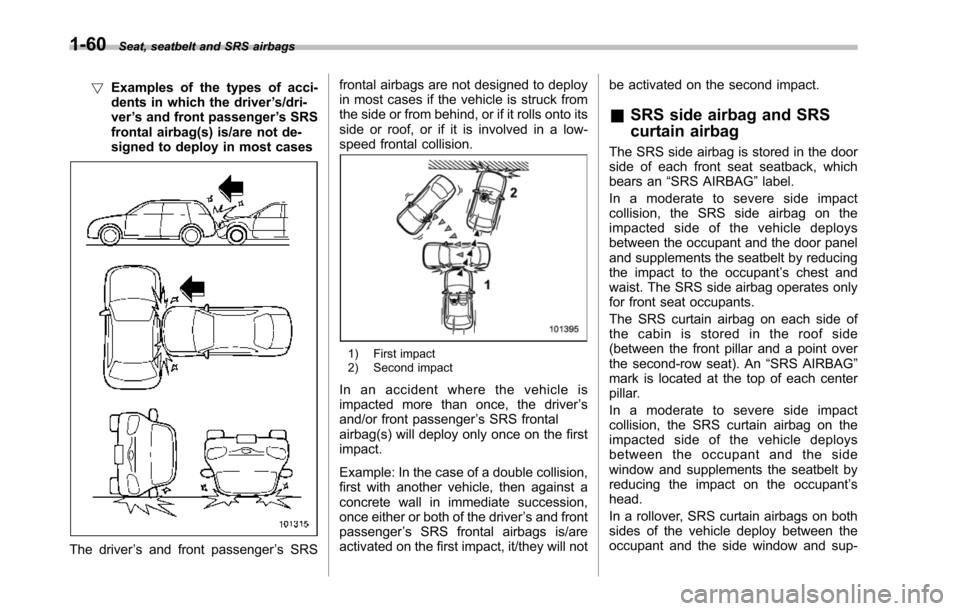
1-60Seat, seatbelt and SRS airbags
!Examples of the types of acci-dents in which the driver’s/dri-ver’s and front passenger’s SRSfrontal airbag(s) is/are not de-signed to deploy in most cases
The driver’s and front passenger’s SRS
frontal airbags are not designed to deployin most cases if the vehicle is struck fromthe side or from behind, or if it rolls onto itsside or roof, or if it is involved in a low-speed frontal collision.
1) First impact2) Second impact
In an accident where the vehicle isimpacted more than once, the driver’sand/or front passenger’s SRS frontalairbag(s) will deploy only once on the firstimpact.
Example: In the case of a double collision,first with another vehicle, then against aconcrete wall in immediate succession,once either or both of the driver’s and frontpassenger’s SRS frontal airbags is/areactivated on the first impact, it/they will not
be activated on the second impact.
&SRS side airbag and SRS
curtain airbag
The SRS side airbag is stored in the doorside of each front seat seatback, whichbears an“SRS AIRBAG”label.
In a moderate to severe side impactcollision, the SRS side airbag on theimpacted side of the vehicle deploysbetween the occupant and the door paneland supplements the seatbelt by reducingtheimpact to the occupant’s chest andwaist. The SRS side airbag operates onlyfor front seat occupants.
The SRS curtain airbag on each side ofthe cabin is stored in the roof side(betweenthe front pillar and a point overthe second-row seat). An“SRS AIRBAG”mark is located at the top of each centerpillar.
In a moderate to severe side impactcollision,the SRS curtain airbag on theimpacted side of the vehicle deploysbetween the occupant and the sidewindow and supplements the seatbelt byreducing the impact on the occupant’shead.
In a rollover, SRS curtain airbags on bothsides of the vehicle deploy between theoccupant and the side window and sup-
Page 93 of 426
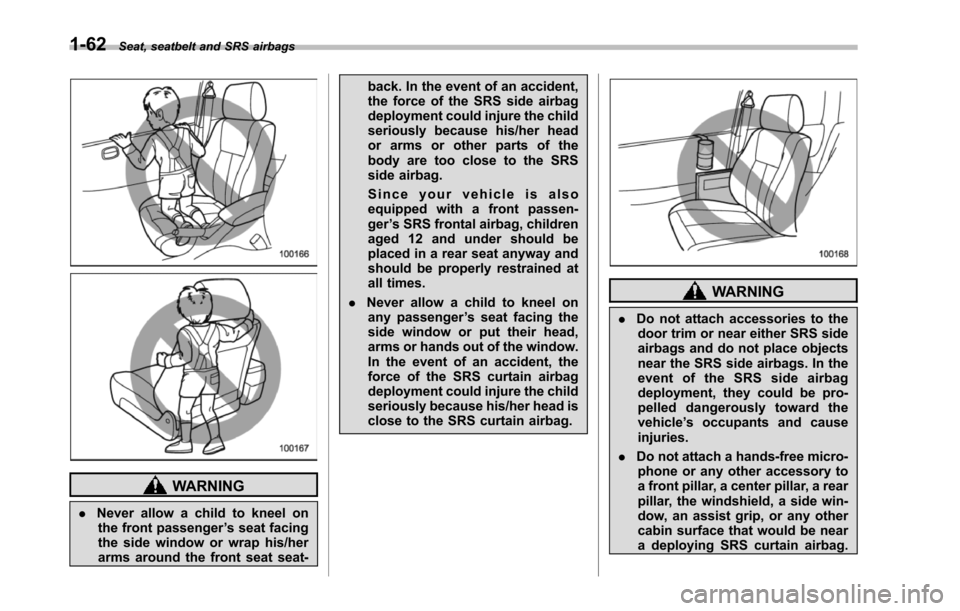
1-62Seat, seatbelt and SRS airbags
WARNING
.Never allow a child to kneel onthe front passenger’s seat facingthe side window or wrap his/herarms around the front seat seat-
back. In the event of an accident,the force of the SRS side airbagdeployment could injure the childseriously because his/her heador arms or other parts of thebody are too close to the SRSside airbag.
Since your vehicle is alsoequipped with a front passen-ger’s SRS frontal airbag, childrenaged 12 and under should beplaced in a rear seat anyway andshould be properly restrained atall times.
.Never allow a child to kneel onany passenger’s seat facing theside window or put their head,arms or hands out of the window.In the event of an accident, theforceof the SRS curtain airbagdeployment could injure the childseriously because his/her head isclose to the SRS curtain airbag.
WARNING
.Do not attach accessories to thedoor trim or near either SRS sideairbags and do not place objectsnear the SRSside airbags. In theevent of the SRS side airbagdeployment, they could be pro-pelled dangerously toward thevehicle’s occupants and causeinjuries.
.Do not attach a hands-free micro-phone or any other accessory toa front pillar, a center pillar, a rearpillar, the windshield, a side win-dow, an assist grip, or any othercabin surface that would be neara deploying SRS curtain airbag.
Page 104 of 426
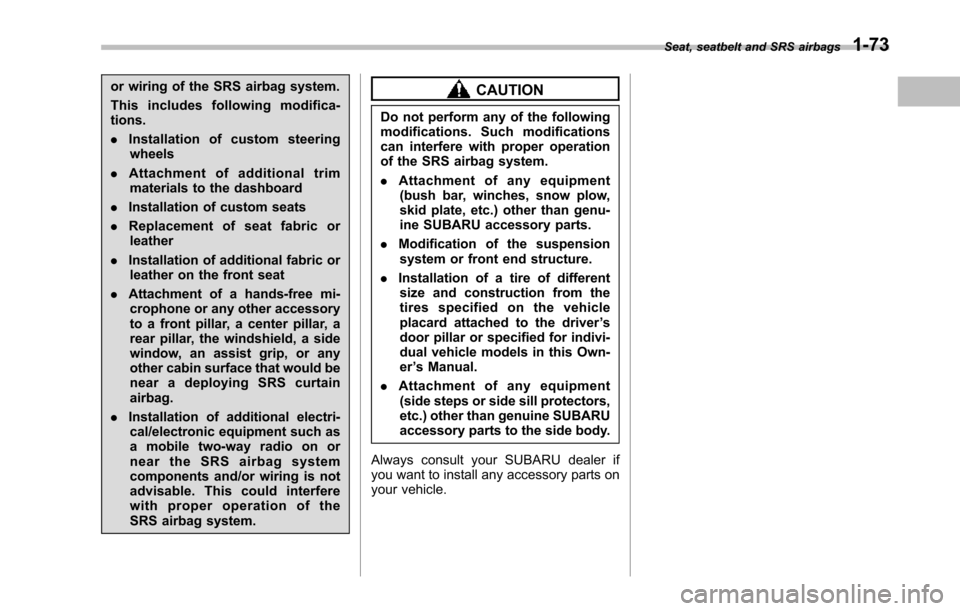
or wiring of the SRS airbag system.
This includes following modifica-tions.
.Installation of custom steeringwheels
.Attachment of additional trimmaterials to the dashboard
.Installation of custom seats
.Replacement of seat fabric orleather
.Installation of additional fabric orleather on the front seat
.Attachment of a hands-free mi-crophone or any other accessoryto a front pillar, a center pillar, arear pillar, the windshield, a sidewindow, an assist grip, or anyother cabin surface that would benear a deploying SRS curtainairbag.
.Installation of additional electri-cal/electronic equipment such asa mobile two-way radio on ornear the SRS airbag systemcomponents and/or wiring is notadvisable. This could interferewith proper operation of theSRS airbag system.
CAUTION
Do not perform any of the followingmodifications. Such modificationscan interfere with proper operationof the SRS airbag system.
.Attachment of any equipment(bush bar, winches, snow plow,skid plate, etc.) other than genu-ine SUBARU accessory parts.
.Modificationof the suspensionsystem or front end structure.
.Installation of a tire of differentsize and construction from thetires specified on the vehicleplacardattached to the driver’sdoor pillar or specified for indivi-dual vehicle models in this Own-er’s Manual.
.Attachment of any equipment(side steps or side sill protectors,etc.) other than genuine SUBARUaccessory parts to the side body.
Always consult your SUBARU dealer ifyou want to install any accessory parts onyour vehicle.
Seat, seatbelt and SRS airbags1-73